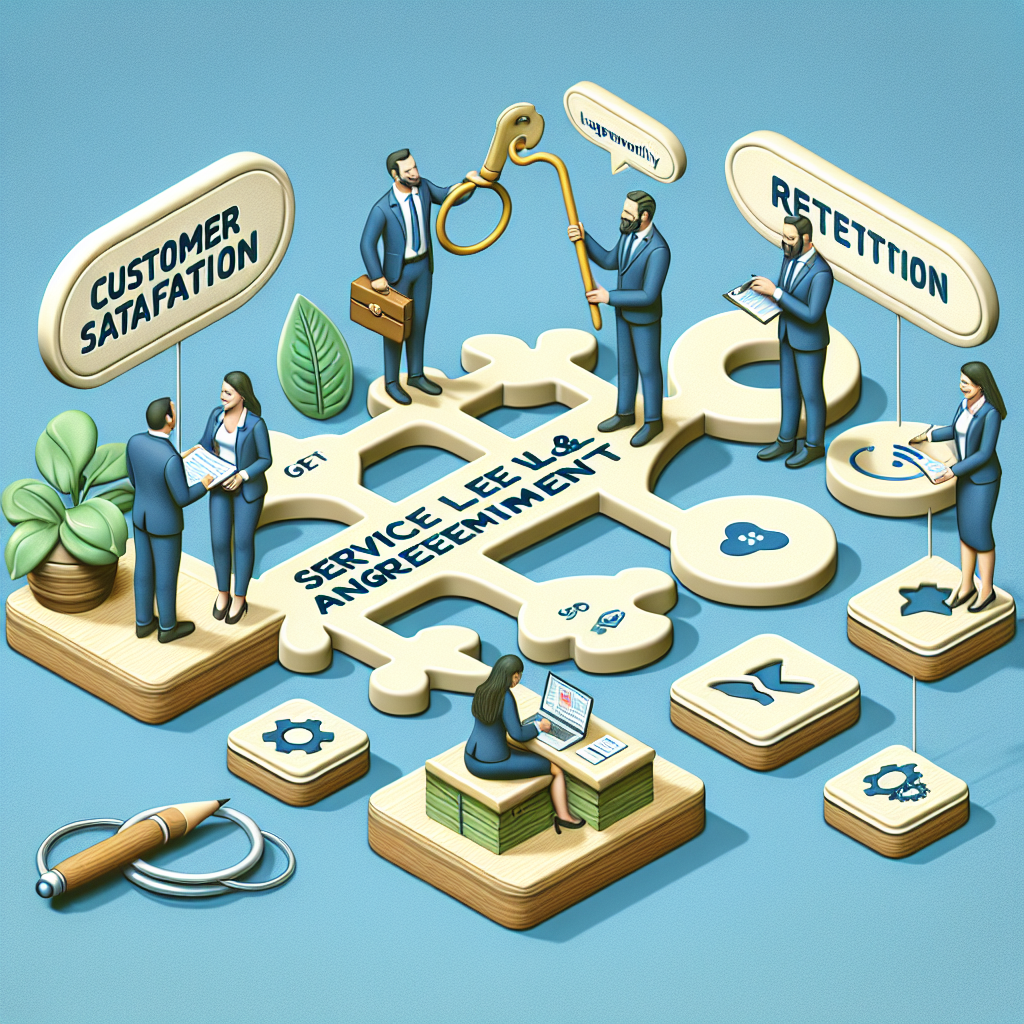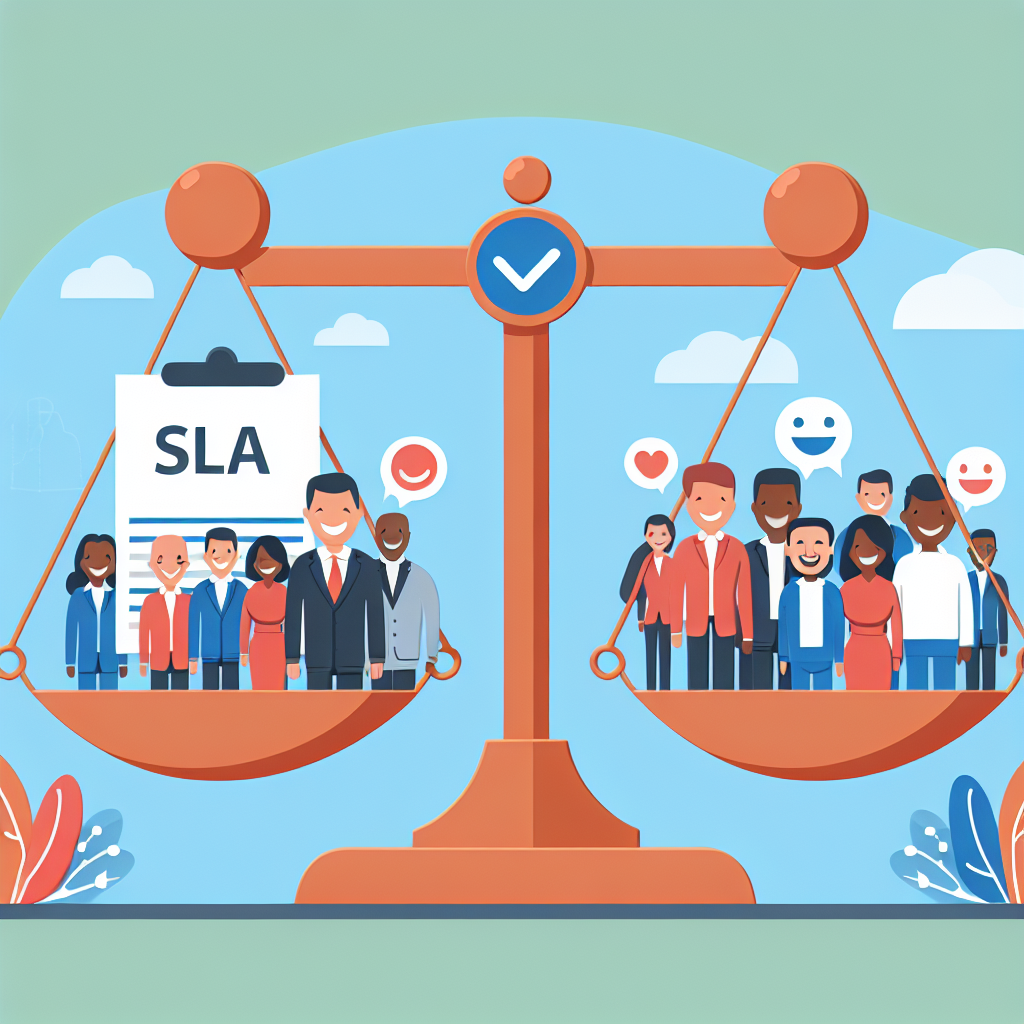Your cart is currently empty!
Tag: SLAs

Understanding the Importance of Service Level Agreements (SLAs) in Business Relationships
Service Level Agreements (SLAs) are crucial documents that outline the expectations and responsibilities of both parties in a business relationship. These agreements are essential for setting clear guidelines for the delivery of services and ensuring that both parties are on the same page.SLAs are particularly important in today’s fast-paced business environment, where companies rely on a wide range of services to operate efficiently. Whether it’s IT services, marketing services, or customer support, having a well-defined SLA in place can help avoid misunderstandings and disputes that can arise when expectations are not clearly communicated.
One of the key benefits of SLAs is that they provide a framework for measuring the performance of service providers. By establishing specific metrics and targets, businesses can track the quality and efficiency of the services they receive. This not only helps in holding service providers accountable but also enables businesses to identify areas for improvement and make informed decisions about their service providers.
SLAs also play a crucial role in managing risk in business relationships. By clearly outlining the responsibilities and liabilities of both parties, SLAs can help mitigate potential disputes and protect both parties in the event of a breach of contract. This can be particularly important when dealing with critical services that can have a significant impact on a business’s operations.
Furthermore, SLAs can help businesses build trust and strengthen relationships with their service providers. By clearly defining expectations and establishing a framework for communication and collaboration, SLAs can help foster a more transparent and productive working relationship. This, in turn, can lead to improved service delivery and greater satisfaction for both parties.
In conclusion, Service Level Agreements are essential tools for managing business relationships and ensuring the smooth delivery of services. By clearly defining expectations, measuring performance, and managing risk, SLAs can help businesses build stronger, more productive relationships with their service providers. Investing the time and effort to create well-crafted SLAs can pay off in the long run, leading to more efficient operations, better outcomes, and ultimately, greater success for your business.

The Role of SLAs in Ensuring Customer Satisfaction and Retention
Service Level Agreements (SLAs) play a crucial role in ensuring customer satisfaction and retention for businesses. SLAs are contracts that outline the level of service that customers can expect from a company, including response times, resolution times, and availability. By setting clear expectations and holding businesses accountable for meeting them, SLAs help to build trust and loyalty with customers.One of the key ways that SLAs contribute to customer satisfaction is by providing transparency and clarity. When customers know exactly what to expect in terms of service, they are more likely to feel confident in their relationship with the company. This transparency helps to build trust and credibility, which are essential for maintaining long-term relationships with customers.
In addition to setting clear expectations, SLAs also help to ensure that businesses deliver on their promises. By establishing specific targets for response and resolution times, companies are held accountable for meeting these goals. This not only improves customer satisfaction by providing timely and efficient service, but also demonstrates the company’s commitment to meeting the needs of their customers.
Furthermore, SLAs can also help to improve communication and collaboration between businesses and customers. By clearly defining roles and responsibilities, SLAs help to streamline the service process and ensure that both parties are on the same page. This can help to prevent misunderstandings and conflicts, leading to a more positive and productive relationship between the company and its customers.
Ultimately, the role of SLAs in ensuring customer satisfaction and retention cannot be overstated. By setting clear expectations, holding businesses accountable, improving communication, and demonstrating a commitment to meeting customer needs, SLAs help to build trust, loyalty, and satisfaction among customers. Businesses that prioritize and uphold their SLAs are more likely to retain customers, drive repeat business, and ultimately achieve long-term success.

Ensuring Compliance and Accountability in Service Level Agreements (SLAs)
In the world of business, Service Level Agreements (SLAs) play a crucial role in ensuring that services are delivered to customers at the agreed-upon level of quality. SLAs are contracts between a service provider and a customer that outline the level of service that will be provided, as well as the consequences if that level of service is not met. However, ensuring compliance and accountability in SLAs can be a challenging task.One of the key ways to ensure compliance and accountability in SLAs is to clearly define the expectations and responsibilities of both parties in the agreement. This means clearly outlining the services that will be provided, the level of quality that is expected, and the timeframe in which those services will be delivered. By clearly defining these expectations, both parties can hold each other accountable for meeting their obligations.
Another important aspect of ensuring compliance and accountability in SLAs is to establish key performance indicators (KPIs) that will be used to measure the performance of the service provider. These KPIs should be specific, measurable, achievable, relevant, and time-bound. By regularly monitoring and measuring these KPIs, both parties can track the performance of the service provider and identify any areas where improvements may be needed.
In addition to defining expectations and establishing KPIs, it is also important to include mechanisms for dispute resolution in the SLA. This can include procedures for escalating issues, as well as provisions for penalties or incentives based on performance. By including these mechanisms in the SLA, both parties can ensure that any disputes or issues are resolved in a timely and fair manner.
Finally, regular communication and review of the SLA is essential for ensuring compliance and accountability. Both parties should regularly review the SLA to ensure that it is still meeting their needs and expectations. By maintaining open lines of communication and being willing to make adjustments as needed, both parties can ensure that the SLA remains effective and relevant.
In conclusion, ensuring compliance and accountability in Service Level Agreements is essential for maintaining a successful business relationship between a service provider and a customer. By clearly defining expectations, establishing KPIs, including mechanisms for dispute resolution, and maintaining open communication, both parties can ensure that the SLA is effective and beneficial for all involved.

The Role of Service Level Agreements (SLAs) in Outsourcing Relationships
Outsourcing has become a popular strategy for businesses looking to streamline their operations and reduce costs. By entrusting certain functions to external service providers, companies can focus on their core competencies and leave non-core activities to experts.However, outsourcing relationships can be complex and challenging to manage. Service Level Agreements (SLAs) play a crucial role in ensuring that both parties are clear on their responsibilities and expectations. An SLA is a contract between a service provider and a client that outlines the level of service that will be provided, including performance metrics, response times, and other key factors.
One of the primary benefits of SLAs in outsourcing relationships is that they help to establish clear expectations from the outset. By defining the scope of services, performance standards, and responsibilities of each party, SLAs help to minimize misunderstandings and conflicts. This can help to build trust and strengthen the relationship between the client and service provider.
SLAs also provide a framework for measuring and monitoring performance. By setting specific targets and metrics, both parties can track progress and ensure that the service provider is meeting their obligations. This can help to identify any issues or gaps in service delivery early on, allowing for timely intervention and resolution.
In addition, SLAs can be used to incentivize performance and drive continuous improvement. By including penalties for non-performance or bonuses for exceeding targets, SLAs can encourage service providers to deliver high-quality services and strive for excellence. This can help to ensure that the client receives the level of service they expect and deserve.
Overall, SLAs play a critical role in outsourcing relationships by providing a clear framework for defining, measuring, and managing service delivery. By establishing clear expectations, monitoring performance, and incentivizing excellence, SLAs help to build strong, collaborative partnerships between clients and service providers. As outsourcing continues to grow in popularity, the role of SLAs will only become more important in ensuring the success of these relationships.

The Impact of Service Level Agreements (SLAs) on Customer Satisfaction
Service Level Agreements (SLAs) are contracts that outline the level of service that a customer can expect from a service provider. These agreements typically include details such as response times, resolution times, and availability of services. SLAs are commonly used in industries such as IT, telecommunications, and customer service to ensure that customers receive the level of service they expect.The impact of SLAs on customer satisfaction cannot be overstated. When customers know exactly what level of service to expect from a provider, they are more likely to be satisfied with the service they receive. This transparency and predictability can help build trust and loyalty between the customer and the provider.
One of the key ways that SLAs impact customer satisfaction is through setting clear expectations. When customers know exactly what level of service they will receive, they are less likely to be disappointed if something goes wrong. For example, if a customer knows that a service provider guarantees a response time of 24 hours for support requests, they are less likely to become frustrated if they do not receive a response within a few hours.
SLAs also help providers prioritize their resources and ensure that they are meeting the needs of their customers. By outlining specific metrics for performance, providers can track their progress and make adjustments as needed to meet their obligations. This can help prevent issues from arising and ensure that customers receive the level of service they expect.
In addition, SLAs can also help improve communication between providers and customers. When both parties are clear on the expectations outlined in the agreement, it can help prevent misunderstandings and miscommunications. This can lead to a more positive customer experience and ultimately, higher levels of satisfaction.
Overall, the impact of SLAs on customer satisfaction is significant. By setting clear expectations, prioritizing resources, and improving communication, SLAs can help providers deliver a higher level of service to their customers. This can lead to increased trust, loyalty, and satisfaction, ultimately benefiting both the customer and the provider.

Maximizing the Benefits of Service Level Agreements (SLAs) for Your Organization
In today’s fast-paced business environment, organizations rely heavily on service level agreements (SLAs) to ensure that their service providers meet agreed-upon performance standards. SLAs are contractual agreements that outline the specific services to be provided, the expected levels of performance, and the consequences for failing to meet those standards. By maximizing the benefits of SLAs, organizations can not only improve the quality of the services they receive but also enhance their overall operational efficiency.One of the key benefits of SLAs is that they establish clear expectations between the organization and its service provider. By clearly defining the scope of services, performance metrics, and responsibilities of both parties, SLAs help to avoid misunderstandings and conflicts that can arise when expectations are not clearly communicated. This clarity can lead to improved communication, increased accountability, and better alignment of goals between the organization and its service provider.
Another benefit of SLAs is that they provide a framework for monitoring and measuring service performance. By establishing key performance indicators (KPIs) and setting benchmarks for success, organizations can track the performance of their service providers and identify areas for improvement. This data-driven approach allows organizations to make informed decisions about the allocation of resources, the prioritization of tasks, and the identification of opportunities for optimization.
In addition, SLAs can help organizations proactively manage risks and mitigate potential disruptions to their operations. By including provisions for service level credits, penalties for non-compliance, and escalation procedures for resolving disputes, SLAs incentivize service providers to maintain high levels of performance and provide mechanisms for holding them accountable when they fall short. This can help organizations minimize the impact of service disruptions, reduce downtime, and ensure continuity of operations.
To maximize the benefits of SLAs for your organization, it is important to establish clear, measurable performance metrics that align with your business objectives and priorities. Work closely with your service provider to define realistic, achievable targets and regularly review and update your SLAs to reflect changing business needs and market conditions. It is also important to communicate expectations clearly, monitor performance regularly, and address any issues or concerns promptly to ensure that your SLAs remain effective and relevant.
By maximizing the benefits of SLAs, organizations can improve the quality of the services they receive, enhance their operational efficiency, and strengthen their relationships with their service providers. By establishing clear expectations, monitoring performance closely, and proactively managing risks, organizations can leverage SLAs as a powerful tool for driving continuous improvement and delivering value to their stakeholders.

Ensuring Compliance with Service Level Agreements (SLAs) in a Changing Business Environment
In today’s rapidly changing business environment, it is more important than ever for companies to ensure compliance with Service Level Agreements (SLAs). SLAs are contracts that outline the level of service that a customer can expect from a service provider, including performance metrics, response times, and other key indicators of quality.As businesses evolve and adapt to new technologies and market demands, it can be challenging to keep up with the requirements of SLAs. However, failing to comply with SLAs can have serious consequences, including financial penalties, loss of business, and damage to reputation.
To ensure compliance with SLAs in a changing business environment, companies must take a proactive approach to monitoring and managing their service delivery. Here are some key strategies to help companies stay on track with their SLAs:
1. Regularly review and update SLAs: As business needs and customer expectations evolve, it is essential to review and update SLAs regularly to ensure they remain relevant and achievable. This may involve revisiting performance metrics, response times, and other key indicators to ensure they align with current business goals.
2. Establish clear communication channels: Clear communication is key to ensuring compliance with SLAs. Service providers must communicate effectively with customers to set expectations, provide updates on service delivery, and address any issues or concerns that may arise. Regular communication can help prevent misunderstandings and ensure that both parties are on the same page.
3. Monitor performance metrics: Monitoring performance metrics is essential for tracking progress against SLAs and identifying areas for improvement. Companies should use monitoring tools and analytics to track key performance indicators, such as response times, uptime, and customer satisfaction, and proactively address any issues that may arise.
4. Implement a robust incident management process: In a changing business environment, incidents and disruptions are inevitable. Companies must have a robust incident management process in place to quickly address and resolve issues that may impact service delivery. This may involve assigning dedicated resources to manage incidents, establishing escalation procedures, and implementing proactive measures to prevent future incidents.
5. Conduct regular performance reviews: Regular performance reviews can help companies assess their compliance with SLAs and identify opportunities for improvement. Companies should conduct regular reviews with both internal teams and external customers to gather feedback, address any concerns, and make adjustments to service delivery as needed.
In conclusion, ensuring compliance with SLAs in a changing business environment is essential for companies to maintain customer satisfaction, drive business growth, and protect their reputation. By taking a proactive approach to monitoring and managing service delivery, companies can stay on track with their SLAs and deliver exceptional service to customers.

Best Practices for Negotiating Service Level Agreements (SLAs) with Vendors
When it comes to negotiating Service Level Agreements (SLAs) with vendors, it is important to establish clear expectations and guidelines to ensure a successful working relationship. SLAs are formal agreements that outline the level of service that a vendor will provide to a client, including the quality, availability, and performance of services. Here are some best practices to consider when negotiating SLAs with vendors:1. Define clear and measurable service levels: Before entering into negotiations with a vendor, it is important to clearly define the services that will be provided and establish measurable metrics for performance. This will help both parties understand what is expected and ensure accountability.
2. Set realistic and achievable goals: When negotiating SLAs, it is important to set goals that are realistic and achievable. Unrealistic expectations can lead to dissatisfaction and conflict down the line. It is important to consider factors such as the vendor’s capabilities, resources, and limitations when setting goals.
3. Establish consequences for non-compliance: In the event that a vendor fails to meet the agreed-upon service levels, it is important to establish consequences for non-compliance. This could include penalties, refunds, or termination of the agreement. Clearly outlining these consequences will help motivate vendors to meet their obligations.
4. Include provisions for monitoring and reporting: It is essential to include provisions for monitoring and reporting in the SLA. This will allow both parties to track performance and identify any issues that may arise. Regular reporting and communication will help ensure that service levels are being met and provide an opportunity to address any concerns in a timely manner.
5. Consider flexibility and scalability: When negotiating SLAs, it is important to consider flexibility and scalability. Business needs may change over time, and it is important to have provisions in place to accommodate these changes. This could include the ability to adjust service levels, add or remove services, or scale up or down as needed.
6. Involve key stakeholders: When negotiating SLAs with vendors, it is important to involve key stakeholders from both parties. This could include representatives from IT, procurement, legal, and other relevant departments. Involving key stakeholders will help ensure that the agreement meets the needs of the organization and that all concerns are addressed.
In conclusion, negotiating SLAs with vendors requires careful planning, clear communication, and a focus on mutual understanding and collaboration. By following these best practices, organizations can establish successful partnerships with vendors and ensure the delivery of high-quality services that meet their business needs.

How to Monitor and Enforce Service Level Agreements (SLAs) for Maximum Efficiency
Service Level Agreements (SLAs) are crucial in ensuring that service providers meet the expectations of their clients. However, simply having SLAs in place is not enough – monitoring and enforcing them is equally important to ensure maximum efficiency and satisfaction for all parties involved.Here are some tips on how to effectively monitor and enforce SLAs for maximum efficiency:
1. Set Clear and Measurable Metrics: The first step in monitoring SLAs is to clearly define the key performance indicators (KPIs) that will be used to measure the service provider’s performance. These metrics should be specific, measurable, achievable, relevant, and time-bound (SMART). This will ensure that both parties have a clear understanding of what is expected and how performance will be evaluated.
2. Use Monitoring Tools: Utilize monitoring tools and software to track and analyze performance data in real-time. These tools can provide valuable insights into areas where the service provider is excelling and where improvements are needed. This information can be used to identify trends, address issues promptly, and make data-driven decisions to optimize service delivery.
3. Regular Reporting and Communication: Establish a regular reporting schedule to review SLA performance with the service provider. This can be done through monthly or quarterly meetings where both parties can discuss performance, address any concerns, and collaborate on solutions to improve service delivery. Open and transparent communication is key to maintaining a strong partnership and ensuring that SLAs are being met effectively.
4. Implement Penalties and Incentives: Include penalties for non-compliance and incentives for exceeding SLA targets in the agreement. This provides motivation for the service provider to consistently meet or exceed performance expectations. Penalties should be fair and reasonable, while incentives can be in the form of bonuses or rewards for exceptional performance.
5. Conduct Regular Audits: Conduct periodic audits to ensure that SLAs are being adhered to and that the service provider is meeting the agreed-upon standards. These audits can help identify any areas of non-compliance or inefficiencies that need to be addressed. It is important to conduct audits objectively and impartially to maintain trust and fairness in the partnership.
6. Continuous Improvement: Encourage a culture of continuous improvement within the service provider organization. This can be achieved through regular feedback, performance reviews, and training opportunities to enhance skills and knowledge. By promoting a learning mindset and a commitment to excellence, the service provider can consistently deliver high-quality services that meet or exceed SLA requirements.
In conclusion, monitoring and enforcing SLAs is essential for maximizing efficiency and ensuring that service providers deliver on their promises. By setting clear metrics, utilizing monitoring tools, fostering open communication, implementing penalties and incentives, conducting regular audits, and promoting continuous improvement, organizations can effectively monitor and enforce SLAs to achieve optimal outcomes for all stakeholders involved.

Benefits of Implementing Service Level Agreements (SLAs) in Your Organization
Service Level Agreements (SLAs) are a crucial component of any organization’s operations. These agreements outline the level of service that a company promises to provide to its customers, both internal and external. By implementing SLAs, organizations can ensure that they are meeting their customers’ expectations and delivering high-quality service consistently.One of the key benefits of implementing SLAs in your organization is improved customer satisfaction. By clearly outlining the level of service that customers can expect, organizations can set clear expectations and ensure that they are meeting them. This helps to build trust with customers and can lead to increased loyalty and retention.
SLAs also help to improve communication within an organization. By clearly defining the roles and responsibilities of each department or team involved in delivering a service, SLAs can help to streamline processes and reduce confusion. This can lead to increased efficiency and productivity within the organization.
Another benefit of implementing SLAs is improved accountability. By establishing specific metrics and targets for service delivery, organizations can hold themselves accountable for meeting these targets. This can help to identify areas for improvement and drive continuous improvement within the organization.
SLAs can also help to manage expectations and reduce conflicts with customers. By clearly outlining the level of service that customers can expect, organizations can prevent misunderstandings and disputes. This can help to build stronger relationships with customers and improve overall customer satisfaction.
In conclusion, implementing Service Level Agreements in your organization can have a range of benefits, including improved customer satisfaction, better communication, increased accountability, and reduced conflicts. By clearly defining the level of service that your organization will provide, you can ensure that you are meeting your customers’ expectations and delivering high-quality service consistently.
